#many Canada geese (5 goslings
Photo
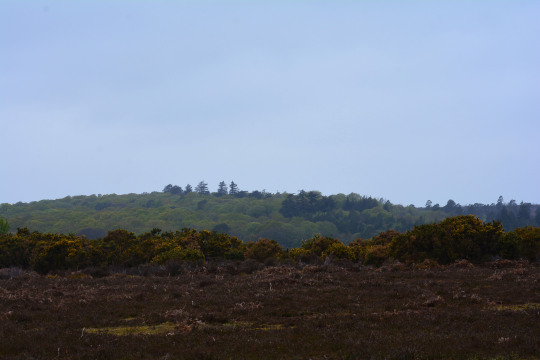
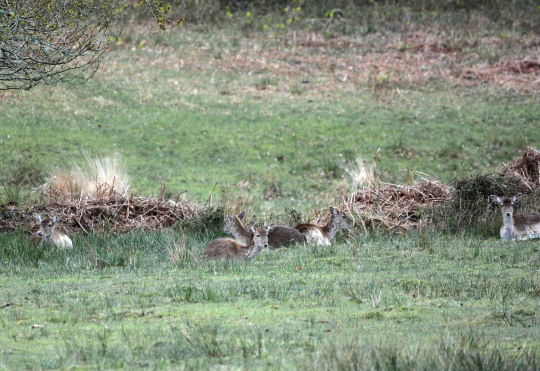
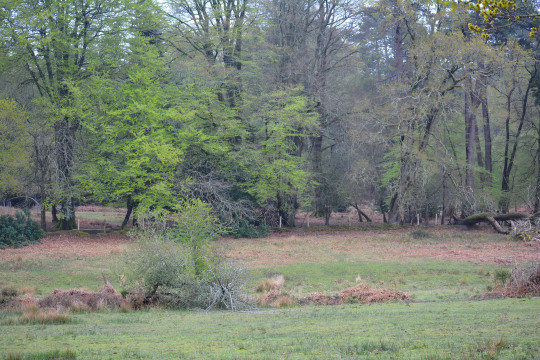

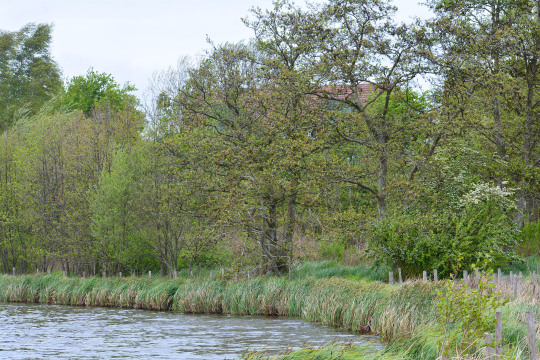
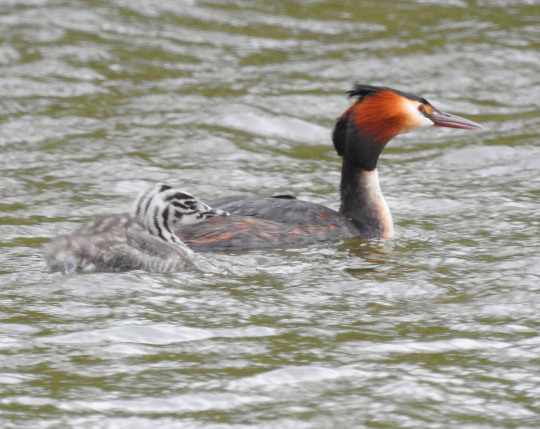


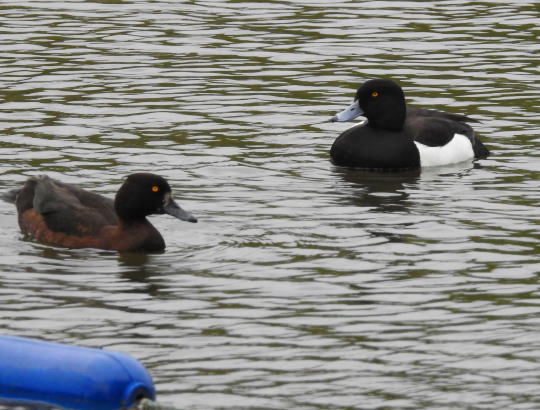

8/5/21-Bolderwood in the New Forest and Lakeside
We had a quite moody and windy walk at Bolderwood today, my first walk in the open forest for a little while whilst I had seen a decent bit of it still on the way to coastal locations and places just beyond the forest on route. It was quite powerful to feel the full force of the wind its something I do find exhilarating as I have said before, I’m maybe more used to this in winter months. And with light rain in the air and luscious green scenes around as well as a little bit blossom and lots of yellow gorse, it had whilst slightly premature on the temperature front one of those atmospheric feels of a muggy overcast day in spring and summer. Days of which I find quite charming so this was nice and there were many beautiful scenes about here today. I took the first, third and fourth pictures in this photoset of views on the walk and tweeted lots more photos from Bolderwood on Dans_Pictures tonight.
There was fantastic wildlife on this walk too. One of my favourite birds the Buzzard flying over escorted by crows and I heard another of my favourites the Cuckoo as well which was brilliant to hear, the fourth location I have heard a Cuckoo this spring so far now after Thursley Common where we also saw one of course, Noar Hill and Stockbridge Common Marsh on Monday. But this was importantly as this national park allowed me to see Cuckoos and build my very happy relationship with them over the past decade my first Cuckoo heard in the New Forest this year this very precious and amazing area for them. Whilst listening to the Cuckoo as you so often do at stronghold for them Bolderwood we were watching a dozen or so Fallow Deers in the field getting a brilliant view of them and for a while both stood up and laid down. We saw a similar herd of maybe slightly less on the way home and I marveled at their beauty and how much I love them again it was a smashing time I am having a great year and few weeks for this species. I took the second pictures in this photoset among others I tweeted showing the deers.
I also saw on the walk; a prominent Raven hacking through the sky, Chaffinch, Robin, some flies and violet, bluebell and spurge flowers.
This evening I had an uncharacteristic Saturday evening Lakeside walk views from it shown in the fifth, seventh, eighth and tenth pictures in this photoset it looked very nice again here. I don’t often come over at the weekend these days as I come here every lunch time to walk whilst working from home in the week, as I had seen some rare birds reported on the goingbirding website for here this morning; Yellow Wagtail and Spotted Flycatcher both I need to see this year and Yellow Wagtail would have been a patch tick here whilst I’ve only ever seen Spotted Flycatchers here once last September. I didn’t see either of these tonight but did use the bonus Lakeside walk as yet another brilliant chance to see the nesting birds of Lakeside, catching up with the Great Crested Grebe and Canada Goose families with two and one young birds respectively I took the sixth picture in this photoset of the grebes and tweeted one of the Canada Geese and at a greater distance a few Greylag Goose families with dozens of goslings which is an entertaining sight really of late here. I also enjoyed seeing a pair of Tufted Ducks as shown in the ninth picture I took today in this photoset I am very much enjoying seeing them around a lot still and I also got another high quality view of a male Blackcap and heard it singing too a very beautiful bird close to a spot I saw one well yesterday.
On beach lake I was thrilled to notice two adorable Mallard ducklings which I tweeted pictures of. They are fairly grown so I am not sure if they were the ducklings I noticed here last month which I only commented today had seemed to have vanished whilst the grebes and goslings have taken centre stage or if this is a new family, but I loved seeing immaculate fluffballs and enjoyed being so close to them. They were on the edge of the lake nicely in front of a bench where I could rather barrier myself behind and take some photos and just enjoy watching them. A theme of the bird photos here tonight was having young almost imitating the position of the parents within the photo and it was interesting to see what they would become.
I also saw at Lakeside tonight; Robin, plenty of House Sparrows busily about still, Starlings, Jackdaw and Magpie well over the northern fenced off nature reserve area and Carrion Crow really well again by beach lake, Blue Tit, Coot, Moorhen and Black-headed Gull.
I hope you all had a nice Saturday.
#bolderwood#new forest#england#hampshire#uk#europe#world#beautiful#wonderful#happy#deers#birds#birdwatching#photography#fallow deer#cuckoo#buzzard#crow#raven#robin#chaffinch#fly#spurge#flower#flowers#lakeside#lakeside country park#satuday#gosling#duckling
2 notes
·
View notes
Text
Branta
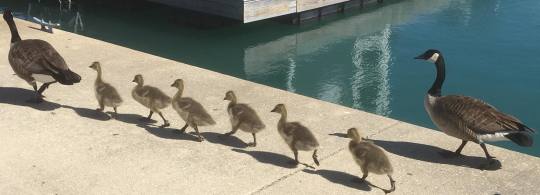
Canada Geese family, by Me!
PLEASE SUPPORT US ON PATREON. EACH and EVERY DONATION helps to keep this blog running! Any amount, even ONE DOLLAR is APPRECIATED! IF YOU ENJOY THIS CONTENT, please CONSIDER DONATING!
Name: Branta
Status: Extant
First Described: 1769
Described By: Scopoli
Classification: Dinosauria, Saurischia, Eusaurischia, Theropoda, Neotheropoda, Averostra, Tetanurae, Orionides, Avetheropoda, Coelurosauria, Tyrannoraptora, Maniraptoriformes, Maniraptora, Pennaraptora, Paraves, Eumaniraptora, Averaptora, Avialae, Euavialae, Avebrevicauda, Pygostylia, Ornithothoraces, Euornithes, Ornithuromorpha, Ornithurae, Neornithes, Neognathae, Galloanserae, Anseriformes, Anseres, Anatoidea, Anatidae, Anserinae
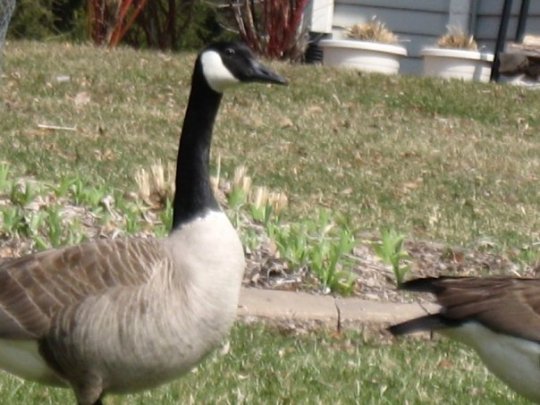
Canada Goose by Me
Referred Species: B. bernicla (Brant Goose, extant), B. ruficollis (Red-Breasted Goose, extant), B. sandvicensis (Nēnē, extant), B. hylobadistes (Nēnē-Nui, extinct), B. rhuax (Giant Hawai’i Goose, extinct), B. canadensis (Canada Goose, extant), B. leucopsis (Barnacle Goose, extant), B. hutchinsii (Cackling Goose, extant), B. woolfendeni (extinct), B. thessaliensis (extinct), B. dickeyi (extinct), B. esmeralda (extinct), B. howardae (extinct), B. propinqua (extinct), B. hypsibata (extinct)

Read-Breasted Goose by Tony Hisgett, CC BY 2.0
Our last entry in this triple-whammy punch of large genera - Branta, the black geese! These include geese from the northern regions of North America and Europe, extending into more temperate regions of North America as well. Being called Black Geese, most have black coloration on their bodies, usually the neck, though the Red-Breasted Goose is also black for most of its body. Their legs and feet are also black or at least very dark grey, which sets them apart from other geese - in addition to being usually smaller, though some are quite large. Those found in Europe are more coastal than the geese of the genus Anser, though those found in North America are found throughout the continent.

Nēnē by Francis C. Franklin, CC BY-SA 4.0
The first specimens of Branta are reported from about 15.97 million years ago, in the Langhian of the Miocene, though these are fairly suspect and its probable that Branta did not appear until later in the Miocene. They probably first appeared in North America, though that is under some debate. B. woolfendeni is known from the Late Miocene of Arizona and one of the earliest known species. B. thessaliensis is known from the Late Miocene of Greece, indicating this bird diversified rapidly if it is from North America. B. thessaliensis also indicates that Branta lived across climate zones prior to the Ice Age, and is only restricted to its current range due to adaptations through the Ice Age. B. thessaliensis is also, interestingly, about the size of the living Canada Goose. B. dickeyi is known form the Pliocene of the Western United States, and B. esmeralda is known from the Early Pliocene of Europe, as is B. howardae. B. propinqua and B. hypsibata are both known from the Pleistocene of Fossil Lake in the United States.

Bernache Goose by Ludovic Péron, CC BY-SA 3.0
Hawai’i back in the day sported two very distinct geese, the Giant Hawai’i Goose and the Nēnē-Nui. The Giant Hawai’i Goose, B. rhuax, lived in the earliest portions of the Holocene, and it is the first fossil bird to be described from Hawai’i. The bones of the bird are rather warped due to lava flow, though it appears to be bigger than other Hawaiian geese and might be as large as the living Cape Barren Goose of Australia, which weighs up to 7 kilograms, though its difficult to tell due to the warped bones. The Nēnē-Nui, or B.hylobadistes, also lived in the Holocene of Hawai’i, specifically Maui, Kaua’i, O’ahu, and possibly Moloka’i. Many subfossils are known of this bird, which indicate it was similar to the living Nēnē. It was evolving towards flightlessness, with most fossil individuals show diminished flight capability at best, with some showcasing flightless individuals with diminished wings. This is one of the few fossil species showing the evolution of the process of flightlessness, rather than the end result. They weren’t completely reproductively isolated from the Nēnē, which was slowing down this process. They went extinct soon after human arrival on the islands.

Brant Goose by Andreas Trepte, CC BY-SA 2.5
The earliest derived living species of Branta is the Brant Goose, a rather small goose with a short and stubby bill and darker, less characteristic plumage than other species in this genus. There are three subspecies, all separated by their particular brand of coloration. These birds spend the summer in Arctic coastal regions of North America and Eurasia, then wintering in more southern portions of these continents and even in Northern Africa. There are permanent populations of these geese, most notably in the United Kingdom, Pacific Coast of the United States, and New England. They weigh up to 2.2 kilograms, making them very small geese indeed.
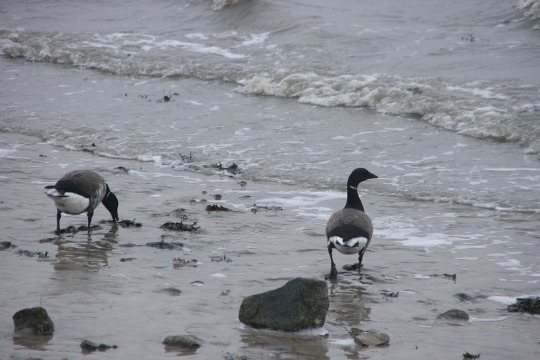
Brant Geese by Henrike Mühlichen, CC BY-SA 3.0
These geese are mostly coastal birds, primarily found in tidal estuaries where it feeds on various sea plants such as seaweed, sea lettuce, and eel-grass. However, some have moved more inland, feeding on agricultural products such as cereals and grass, potentially copying other geese in doing so. They are considered to be not threatened with extinction, though some North American populations have been badly hit in the past.

Red-Breasted Goose by Iorentey, CC BY 2.0
Even more visually distinct from other members of the genus than the Brant Goose, the Red-Breasted Goose is seemingly a visual outlier - with red feathers on its neck and chest and black and white feathers all over its body, it looks like it should be a completely different type of goose. And yet, it is not. B. ruficollis is known primarily from Eurasia, breeding in Siberia and migrating down to Eastern Europe and Central Asia during the winter. These birds are vulnerable to extinction, due to limited sites utilized during the breeding season, sites that are threatened due to human land use. Conservation efforts are ongoing in attempts to preserve the species.

Red-Breasted Goose by Dick Daniels, CC BY-SA 3.0
The Red-Breasted Goose usually weighs only about 1.5 kilograms, making it a very small bird indeed. It makes a shrill and staccato call, and despite its small size it actually prefers to nest alongside birds of prey like owls and falcons, which helps to protect their eggs from mammal predators. The birds of prey protect the geese from predators, and rarely attack them themselves. They have very large nesting colonies, which also contribute to safety in their habitats. They also nest on rivers and islands, but they prefer using birds of prey for protection instead. THeir colonies have usually about 4 pairs, though there can be more if food is abundant, and they rarely leave a 1.5 kilometer radius of the nest. The males guard the young from a distance, while the females roost on the nest. They feed mainly on grasses, leaves, and seeds.
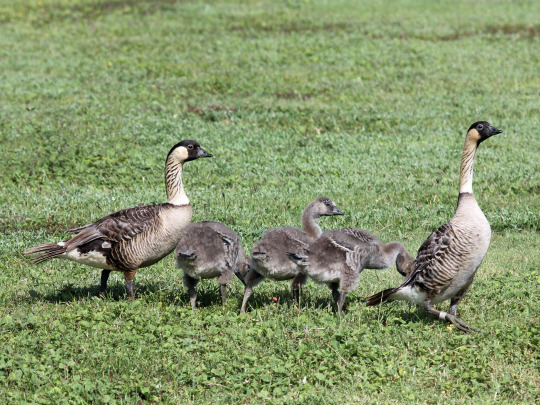
Nēnē by Dick Daniels, CC BY-SA 3.0
The Nēnē is where we finally start inching towards the common color pattern of Branta, though it is browner potentially as an adaptation for a more terrestrial lifestyle. It is a goose endemic to Hawai’i, and is the state bird of Hawai’i! It is found on Oahu, Maui, Kaua’i, Molokai, and Hawai’i itself, in terms of specific islands, and its name comes from its soft call. It is the world’s rarest goose, almost driven extinct due to human activity and introduced mammal predators (thanks, humans). Today, conservation efforts and breeding programs have successfully gotten the population from 30 birds to 2,500 birds, though it’s still considered vulnerable and efforts are heavily ongoing.

Nēnē by Caracas1830, CC BY-SA 2.5
The Nēnē is about 8.6 kilograms in weight, and it is closely related to the Canada Goose, and may have even evolved from it, though that is under some debate. They spend most of their time on the ground and have very distinctive feet, widely splayed flippers that give them more surface area while walking on the ground. They are capable of flight, however, though they still primarily live inland in shrubland, grassland, dues, and lava plains. They feed on leaves, seeds, fruit, and flowers as well as grass and shrubs. They breed from August to April, so for a long period of time, longer than any other goose species. They nest on land, unlike other waterfowl, and the female lays between one to five eggs and incubates them for about a month, while the male guards. The goslings then stay with their parents until the next breeding season.

Canada Goose by Daniel D’Auria, CC BY-SA 2.0
The Canada Goose, B. canadensis, is arguably the most famous goose - at least to people in America - due to it rather common state. It is native to the arctic and temperate regions of North America, and it does extend into northern Europe, introduced into the United Kingdom, New Zealand, Argentina, Chile, and the Falkland Islands. These birds are very successful in living in urban areas, to the point where I can’t really go anywhere in Chicago (my home) without seeing one. They tend to breed well in park areas, and they beg for food from humans around them, which just kind of exacerbates the problem. Honk.
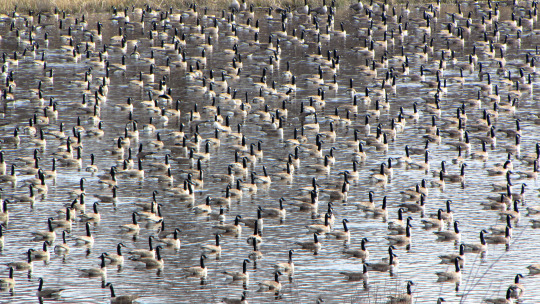
Canada Geese by D. Gordon E. Robertson, CC BY-SA 3.0
Canada Geese were, at one point, threatened with extinction due to over-hunting and human activity (most notably aircraft strikes), but conservation efforts for this bird may be too successful, with between 4 and 5 million birds estimated in North America alone, in the year 2000. Today, culls of geese in densely populated areas occur, but the bird is still protected under environmental laws and is not legal to be hunted most times of the year. I personally don’t ultimately see a problem with this in North America. In Eurasia, their introduction does pose a threat to agricultural and native goose populations, and introduction in New Zealand also threatens agricultural practices, making their presence in these regions a serious problem.
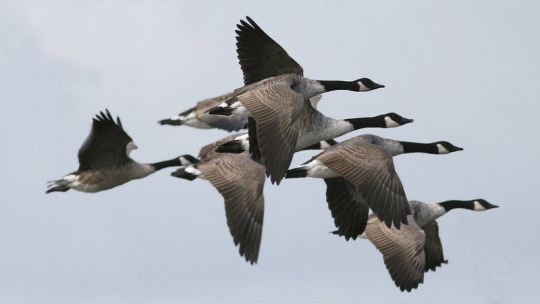
Canada Geese by Ken Billington, CC BY-SA 3.0
These birds weigh up to 10.9 kilograms, though they usually don’t exceed eight kilograms, and have very large wingspans that aid in their long flights and migrations. They have a distinctive white chinstrap on their black heads, and brown feathers throughout the bodies, as well as black legs and necks. Migratory birds, they form V-shaped flying formations while moving across North America during the spring and autumn. They usually spend the summers in Canada, and the winters in Southern United States, with year-round birds found in the Northern United States (so, you know, where I live). (They’re everywhere).
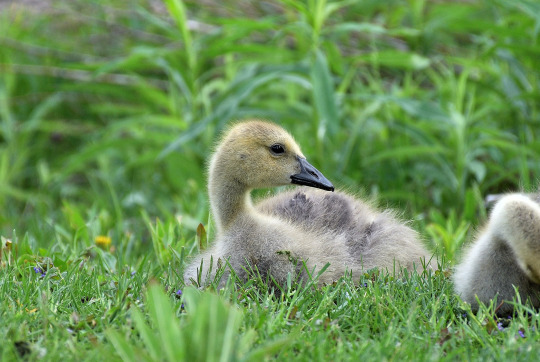
Canada Gosling by Saud, CC BY-SA 4.0
The Goslings are yellow and grey, becoming more grey as they age and then receiving adult plumage when they reach sexual maturity. The geese are monogamous, usually staying with the same mate for their whole lives, unless they are widowed at which point they find a new mate. The female lays two to nine eggs and incubates them, while the male finds food and tends to wander around. They nest near streams, lakes, and ponds for about 28 days. The goslings are immediately capable of walking, swimming, and finding food, with the parents leading the goslings in a line with one adult at the front and the other at the back, and the adults are violently protective of their chicks. Though, speaking from experience, if you’re a small child just reading a book by the pond and a bunch of geese start gathering around you, they probably won’t mind your presence. And might even remember you. So for their lifespan of ten to twenty four years they might just continue to be chill with your presence at the pond by your house. But that’s just my guess. The offspring fledge at about 9 weeks and dont’ leave their parents until they return to their birthplace.

Barnacle Goose by Andreas Trepte, CC BY-SA 2.5
The Barnacle Goose is next on our series of black geese, and it is in fact blacker than the geese we have seen so far, with distinctively dark necks and more monochromatic plumage. They weigh up to about 2.23 kilograms, making them fairly small as far as geese go. They are known primarily from Eurasia, breeding up in Greenland, Scotland, Ireland, Norway, and the Netherlands. Some have managed to migrate to the United States and Canada, but these expansions are rare, and oftentimes a wild Barnacle Goose is just a mistaken escaped one (they are popular waterfowl to collect, apparently).

Barnacle Geese by MPorciusCato, CC BY-SA .30
These geese build their nests on high mountain cliffs away from predators and food, and rather than adults bringing food to their goslings, the goslings go out to get their own food! The three-day-old goslings fall off the cliffs and their small size and feathery down help to protect them when they hit the rocks below, but oftentimes they just straight-up die, so that’s... a thing. Arctic foxes then prey on many of them as the adults lead them to wetlands for gathering food. Still, the Barnacle Goose does not appear to be threatened with extinction. Their weird mode of reproduction has lead to many legends being woven about them, such as that they came from driftwood; they are so different from other waterfowl that there’s a separate kosher ruling about them, decreeing that they are, in fact, kosher. But I wouldn’t eat them regardless.

Cackling Goose by Tim Bowman, in the Public Domain
The Cackling Goose is our last member of the genus, and it is essentially indistinguishable from the Canada Goose, with lots of overlapping range. They were made into a full species in 2004, though frustration amongst ornithologists remains because, again, they look the same. Still, they do extend into other locations, notably Russia; and they tend to be smaller than Canada Geese on average, but some can weigh up to 3 kilograms and approach the size of Canada Geese. They nest in shallow depressions near the water, in locations lined with plant material. They mate for life, and they will also parade their goslings, in order to reach plant material. They even can tip forward to feed on aquatic plant material, in a sort of dabbling pose. Sometimes they also eat insects, molluscs, and crustaceans. They do not appear to be threatened with extinction. Still, just to drive home how aggravating these birds are, they are probably most closely related to Barnacle Geese, not Canada Geese. There you have it.

Cackling Goose, by Tim Bowman, in the Public Domain
Sources:
https://en.wikipedia.org/wiki/Branta
http://fossilworks.org/?a=taxonInfo&taxon_no=83426
https://en.wikipedia.org/wiki/Branta_thessaliensis
https://en.wikipedia.org/wiki/Branta_rhuax
https://en.wikipedia.org/wiki/N%C4%93n%C4%93-nui
https://en.wikipedia.org/wiki/Brant_(goose)
http://www.luontoportti.com/suomi/en/linnut/red-breasted-goose
https://en.wikipedia.org/wiki/Red-breasted_goose
https://en.wikipedia.org/wiki/Nene_(bird)
https://en.wikipedia.org/wiki/Canada_goose
https://en.wikipedia.org/wiki/Barnacle_goose
https://en.wikipedia.org/wiki/Cackling_goose
#goose#black geese#branta#dinosaur#duck#bird#birblr#palaeoblr#canada goose#brant goose#barnacle goose#cackling goose#red-breasted goose#nene#nēnē#factfile#dinosaurs#biology#a dinosaur a day#a-dinosaur-a-day#dinosaur of the day#dinosaur-of-the-day#science#nature#branta bernicla#branta leucopsis#branta canadensis#branta hutchinsii#branta ruficollis#branta sandvicensis
75 notes
·
View notes